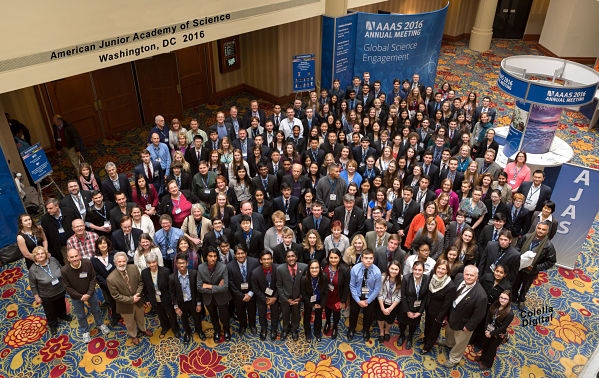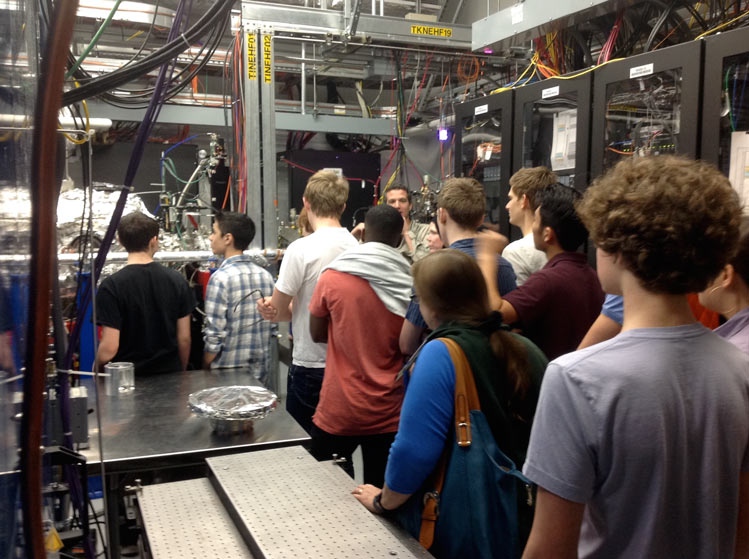AJAS
About AJAS
Photos from 2024 AJAS Meeting in Denver
The American Junior Academy of Sciences (AJAS) is the only US honor society recognizing America's premier high school students for outstanding scientific research. Each state's Academy of Science nominates high school students as AJAS delegates. The chosen delegates are then invited to attend the AJAS annual conference. The AJAS mission is to introduce, encourage, and accelerate pre-college students into the professional world of science, technology, engineering, and mathematics.
Each state's Academy of Science determines the guidelines by which their AJAS delegates are chosen. In many cases, the Academy of Science organizes a Junior Academy of Science. Under the direction of the Junior Academy, a statewide scientific research competition is held.
The winners of these competitions are nominated to represent their state at the AJAS conference. Interested students and mentors should contact their state Academy of Science for information on how to get involved.
AJAS meets annually in conjunction with the American Association for the Advancement of Science’s (AAAS) annual meeting. AAAS is the largest scientific organization in the world and the publisher of Science. AAAS serves as an authoritative source for information on the latest developments in science and bridges gaps among scientists, policy-makers and the public to advance science and science education.
During the conference, AJAS delegates:
tour local institutions of scientific importance,
share their research with their peers and with other scientists,
participate in interactive laboratory experiences
attend conference sessions
gain exposure to cutting edge technology,
meet world-renowned scientists,
participate in field trips, plenary lectures, and small group meetings
At the end of the meeting, the students are inducted as lifetime Fellows into the American Junior Academy of Science.
AJAS is very unique because it is not a competition, rather it is a conference that celebrates student success by introducing them to the social, cultural, intellectual, and professional aspects of STEM professions.
AJAS is a program of the National Association of the Academics of Science (NAAS). NAAS is the national organization for the state science academies and is an affiliate member of AAAS.
2023 AJAS Annual Meeting
2023 AJAS Photo Album
COVID Policy
AJAS will follow the COVID policies and guidelines for the AAAS Annual Meeting.
2021 American Junior Academy of Science posters
AJAS presentations in the 2021 AAAS Meeting Program
2021 AJAS Conference Brochure
Top high school researchers from across the nation meet at MIT
From MIT News
Talented high school researchers attending the annual AAAS/AJAS conference in Boston meet with MIT faculty.
Jana Hersch | School of Science
March 8, 2017
On Feb. 17, MIT hosted some of the nation‘s most talented high school student researchers for a Breakfast with Scientists at the American Junior Academy of Science (AJAS) conference, held in conjunction with the 2017 annual meeting of the American Association for the Advancement of Science in Boston.
The breakfast was a unique opportunity for students to receive advice and encouragement from scientists working at the top of their fields, among them Nobel Prize laureates such as Phillip Sharp and Bob Horvitz, both professors in the MIT Department of Biology. In total, 14 MIT faculty members attended, along with distinguished faculty from other universities, pharmaceutical and biotechnology leaders and inventors, and the editor-in-chief of Sciencemagazine, Jeremy Berg. Discussions ranged in topic from what it means to be a scientist today to career paths to fundamental research.
Speaking with someone who is passionate about something you are doing and are in awe of what you have done is an eye-opening and amazing experience, said Chase Bishop, a delegate from North Carolina. The tour of MIT was also very cool. I got to see things that I have seen on science shows, but I was right next to the people who had done it. I‘ll definitely be sending my application there.
This year, 124 students were selected to attend AJAS based on their outstanding research, which they presented at competitions such as the Intel International Science and Engineering Fair, research symposia, and the Massachusetts State Science and Engineering Fair, hosted by MIT.
Although many of the students conducted their research at home without access to state-of-the-art tools and techniques found in laboratories, their understanding of the scientific method and its applications is sophisticated.
I sat next to an eighth-grader from Massachusetts who blew my socks off in his efforts to recycle trash into something useful, said Joanne Stubbe, a National Science Medalist and Novartis Professor Emerita in the MIT Department of Chemistry. He was amazingly articulate, clearly loved science, and understood its translational importance.
Sponsored by the School of Science, the School of Engineering, and the School of Architecture and Planning, the event is part of a long tradition at MIT of supporting promising young researchers early on.
"They are a remarkable group of young people, with great energy, insights, and varied interests, said Ian A. Waitz, dean of engineering at MIT. "With so many challenges in the world and so much to be discovered, it is inspiring to know that many of them will be future leaders in science and technology.
AJAS 2016 - Washington D.C.
A big thank you to everyone who participated in AJAS 2016 in Washington D.C.!
 Image Credit to Michael J. Colella
Image Credit to Michael J. Colella
Hi-Res
High school students see science in action at Stanford
by Elaine Ray on March 10, 2015 4:00 am
Source: http://news.stanford.edu/thedish/2015/03/10/37109/
When the world‘s most accomplished scientists gathered for the annual meeting of the American Association for the Advancement of Science (AAAS) in San Jose recently, a cadre of the nation‘s most promising high school scientists gathered too.
Some of those students had an opportunity to experience science at Stanford during a visit to the SLAC National Accelerator Laboratory and to the main campus.
The 36 students who participated in the Stanford tour were fellows in the American Junior Academy of Science (AJAS), a national honor society for students who have completed exemplary scientific research projects while attending high school. Each affiliated (city, state, or regional) Academy of Science nominates their top high school science researchers, and these students, along with their teachers, are invited to the AJAS annual conference, held during the AAAS annual meeting.

The students, who were accompanied by teachers, parents and other officials, began their day at SLAC, a U.S. Department of Energy Office of Science facility operated by Stanford.
JOSH TURNER, a scientist at Linac Coherhent Light Source (LCLS), presented a day in the life at an x-ray laser. The students also toured the LCLS‘s experimental halls and visited the klystron gallery – looking down the two-mile accelerator.
The students and accompanying chaperones were able to see science in action as researchers prepared experiments, visiting stations set for recreating extreme states of matter (like those at the heart of Jupiter) and for studying the atomic structures of complex and critical proteins like those active in photosynthesis, said MELINDA LEE, who manages community relations for the SLAC Office of Communication. ’Cool‘ and ’Awesome‘ were most frequently used descriptors, Lee added.
Following the SLAC visit, the group visited the main campus and spent time in the Chemistry Department. They were blown away by the science and captivated by the beauty of the campus.
HENRY MAGUN, a Stanford freshman and former AJAS fellow, helped with planning the visit and checked in with the students while they were on campus.
 AJAS Videos and Podcasts
AJAS Videos and PodcastsMIT Hosts American Junior Academy of Science Delegates
From MIT news
The Institution provides day‘s worth of activities for more than 200 conference attendees.
Department of Biology
MIT hosted a full day of activities on Feb. 14 for 232 American Junior Academy of Science delegates — high school students, parents and teachers from across the nation — who were in Boston to attend the academy‘s annual conference.
The day started with a well-received lecture on brain plasticity by Mriganka Sur, the Paul E. Newton Professor of Neuroscience at MIT. It was absolutely fantastic to be given the opportunity to listen to a prominent professor talk about his work, said Kanithra Sekaran, a high school student from Ohio who is now contemplating a career in neuroscience.
After the talk, the students visited research labs and met with MIT scientists, had lunch with graduate students at the Faculty Club, toured the campus and ended the day with a free visit to the MIT Museum. In total, 17 labs and more than 30 MIT scientists took part in the event.
Mandana Sassanfar, director of science outreach for the Biology and Brain and Cognitive Sciences departments, organized the day for the delegates. "Seeing such excitement and interest from these talented high schoolers is a wonderful reminder of how important it is for scientists to inspire and encourage young students to pursue a career in science and technology, said Sassanfar, who is president of the National Association of Academies of Science, an affiliate of the American Association for the Advancement of Science (AAAS).
MIT Institute Professor Phillip Sharp, who is the new president of AAAS, praised the AJAS delegates during their visit. "The American Junior Academy of Science recognizes the remarkable achievements of young scientists in independent research," he said. Their projects have been selected from across the nation as the most outstanding and we congratulate them.
The high school students had positive things to say about MIT, as well.
The best part about our tour day at MIT was seeing real scientists working in their labs on cutting edge research, said Hale Miller of Ohio.
They [the scientists] were so excited about their work, and so wiling to share everything they knew, added Michelle Nemetchek, one of two students from Montana.
Some students reveled in the behind-the-scenes lab visits. I‘ve seen some images of fiber construction on TV shows, but being able to see first hand the process behind designing and developing these fibers was a very cool experience, Jonathan Flynn, a senior from Braintree High School, said after visiting the Fink lab in the Research Laboratory of Electronics.
In that lab, postdoc Xiaoting Jia explained the making of microfibers for superconductors and demonstrated how preformed fibers were extended in the drawing tower located in the basement of Building 13. It was very exciting for me to see so much curiosity from these high school students, Jia said. I really enjoyed the experience.
MIT‘s Media Lab was a favorite stop for California‘s Léa Tran Le, who uses Scratch, children‘s programming software designed in the lab. I really enjoyed learning about CT scanning machines in the animal imaging facilities and seeing Eric Rosenbaum's research in helping kindergartners learn better through Scratch, she said.
In fact, the Media Lab was a popular destination for a few others in the tour group, as well. The Media Lab was amazing, said Grace Griggs, a sophomore from Vermont. It was like a scientist‘s playground of crazy, creative inventions.
Meeting the creators of objects used in our everyday lives was quite inspirational, added Hayden Allen, a senior from Oklahoma.
MIT students and staffers who exhibited their work for the tour said the students were certainly an inquisitive bunch. They were very engaged and very interested to hear what kind of problems we were working on, said Michael Funk, a fourth-year chemistry graduate student who works in the Drennan Research and Education Laboratory.
A couple asked very insightful questions, added Bob Grant, who showed students around the Structural Biology Core Facility, which he directs.
The event was co-sponsored by the schools of Science, Engineering, and Architecture and Planning, as well as the Biology and Brain and Cognitive Sciences departments.
